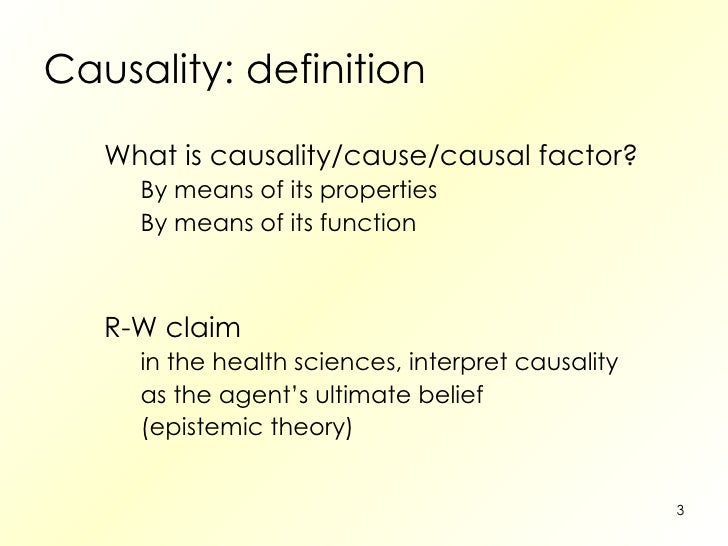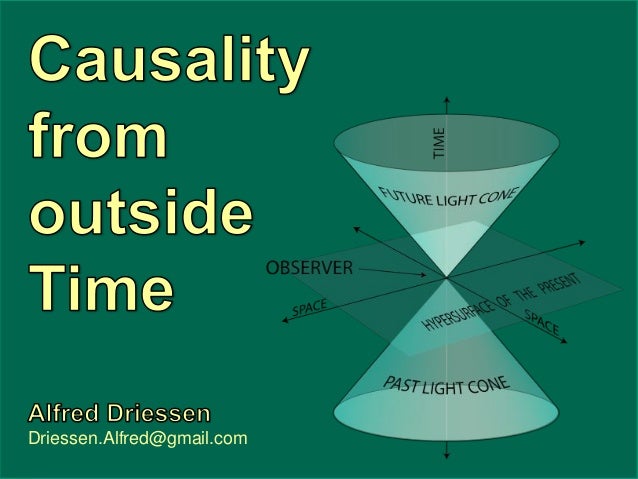Causality
- Noun, plural causalities. The relation of cause and effect: The result is the same, however differently the causality is interpreted. Causal quality or agency.
- These restrictions are based on a particular conceptual framework for thinking about causality. In Section 1, we describe the characteristics of the restricted potential outcomes approach (RPOA) and show that there is a methodological movement which advocates these principles, not just for solving particular problems, but as ideals for which.
Causality 2
Causality is the science of cause and effect. Things influence other things. That’s a basic statement of any dynamic world where things change, and things would be very dull if it weren’t the. Find 165 ways to say CAUSALITY, along with antonyms, related words, and example sentences at Thesaurus.com, the world's most trusted free thesaurus. Causality definition: 1. The principle that there is a cause for everything that happens 2. The principle that there is a.
Cosmological arguments attempt to prove God’s existence by observing the world around us (the cosmos). They begin with what is most obvious in reality: things exist. It is then argued that the cause of those things’ existence had to be a “God-type” thing. These types of arguments go all the way back to Plato and have been used by notable philosophers and theologians ever since. Science finally caught up with theologians in the twentieth century, when the fact that the universe had a beginning was confirmed. So, today, the cosmological arguments are even powerful for non-philosophers.There are two basic forms of cosmological arguments, and the easiest way to think of them might be the “vertical” and the “horizontal.” These names indicate the direction from which the causes come. The argument in the vertical form is that every created thing is being caused right now (imagine a timeline with an arrow pointing up from the universe to God). The horizontal version shows that creation had to have a cause in the beginning (imagine that same timeline, only with an arrow pointing backward to a beginning point in time).
The horizontal cosmological argument, also called the kalam cosmological argument, is a little easier to understand because it does not require much philosophizing. The basic argument is that all things that have beginnings had to have causes. The universe had a beginning; therefore, the universe had a cause. That cause, being outside the whole universe, is God. Someone might say that some things are caused by other things, but this does not negate the argument, because those other things had to have causes, too, and this cannot go on forever.
To illustrate the kalam, or the horizontal cosmological argument, let’s take a simple example: trees. All trees began to exist at some point (for they have not always existed). Each tree had its beginning in a seed (the “cause” of the tree). But every seed had its beginning (its “cause”) in another tree. There cannot be an infinite series of tree-seed-tree-seed, because no series is infinite. All series are finite (limited) by definition. There is no such thing as an infinite number, because even the number series is limited (although you can always add one more, you are always at a finite number). If there is an end, it is not infinite. All series have two endings, actually—one at the end and one at the beginning (try to imagine a one-ended stick!). If there were no first cause, then the chain of causes never would have started. Therefore, there is, at the beginning at least, a first cause—one that had no beginning. This first cause is God.

The vertical form of cosmological argument is a bit more difficult to understand, but it is more powerful. Not only does the vertical argument show that God had to cause the “chain of causes” in the beginning, but it shows He must still be causing things to exist right now. Again, we begin by noting that things exist. Next, while we often tend to think of existence as a property that things sort of “own”—that once something is created, existence is just part of what it is—this is not the case. Consider the triangle. We can define a triangle as “the plane figure formed by connecting three points not in a straight line by straight line segments.” Notice what is not part of this definition: existence.
This definition of a triangle would hold true even if no triangles existed at all. Therefore, a triangle’s nature—what it is—does not guarantee that one exists (like unicorns—we know what they are, but that does not make them exist). Because it is not part of a triangle’s nature to exist, triangles must be made to exist by something else that already exists (someone must draw a triangle). The triangle is thus caused by something else—which also must have a cause. This cannot go on forever (there are no infinite series). Therefore, something that does not need to be given existence must exist to give everything else existence.
Causality In Research
Now, apply this example to everything in the universe. Does any of it exist on its own? No. So, the universe had to have a first cause to get started, and it also needs something to give it existence right now. The only thing that would not have to be given existence is a thing that exists as its very nature. It is existence. This something would always exist, have no cause, have no beginning, have no limit, be outside of time, and be infinite. That something is God, the “I AM” of Exodus 3:14. “The heavens declare the glory of God, and the sky above proclaims his handiwork. Day to day pours out speech, and night to night reveals knowledge” (Psalm 19:1–2).
In control theory, a causal system (also known as a physical or nonanticipative system) is a system where the output depends on past andcurrent inputs but not future inputs—i.e., the output depends on only the input for values of .
The idea that the output of a function at any time depends only on past and present values of input is defined by the property commonly referred to as causality. A system that has some dependence on input values from the future (in addition to possible dependence on past or current input values) is termed a non-causal or acausal system, and a system that depends solely on future input values is an anticausal system. Note that some authors have defined an anticausal system as one that depends solely on future and present input values or, more simply, as a system that does not depend on past input values.
Classically, nature or physical reality has been considered to be a causal system. Physics involving special relativity or general relativity require more careful definitions of causality, as described elaborately in Causality (physics).
The causality of systems also plays an important role in digital signal processing, where filters are constructed so that they are causal, sometimes by altering a non-causal formulation to remove the lack of causality so that it is realizable. For more information, see causal filter.
For a causal system, the impulse response of the system must use only the present and past values of the input to determine the output. This requirement is a necessary and sufficient condition for a system to be causal, regardless of linearity. Note that similar rules apply to either discrete or continuous cases. By this definition of requiring no future input values, systems must be causal to process signals in real time.[1]

Mathematical definitions[edit]
Definition 1: A system mapping to is causal if and only if, for any pair of input signals , and any choice of , such that
Causality Meaning
the corresponding outputs satisfy
Definition 2: Suppose is the impulse response of any system described by a linear constant coefficient differential equation. The system is causal if and only if
otherwise it is non-causal.
Examples[edit]
The following examples are for systems with an input and output .
Examples of causal systems[edit]
- Memoryless system
- Autoregressive filter
Examples of non-causal (acausal) systems[edit]
Causality David Hume
- Central moving average
Examples of anti-causal systems[edit]
- Look-ahead

References[edit]


- ^McClellan, James H.; Schafer, Ronald W.; Yoder, Mark A. (2015). DSP First, Second Edition. Pearson Education. p. 151. ISBN978-0136019251.
- Oppenheim, Alan V.; Willsky, Alan S.; Nawab, Hamid; with S. Hamid (1998). Signals and Systems. Pearson Education. ISBN0-13-814757-4.